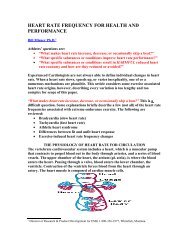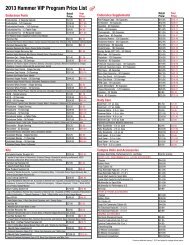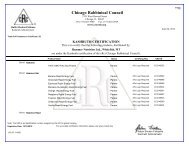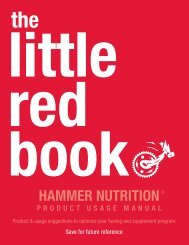Create successful ePaper yourself
Turn your PDF publications into a flip-book with our unique Google optimized e-Paper software.
NMES<br />
Incorporating Compex into your training<br />
Pre-season<br />
Compex training:<br />
Build power and VO 2 max<br />
BY JIM BRUSKEWITZ<br />
Increasing VO 2 max (the maximum<br />
amount of oxygen one’s muscles<br />
can use when exercising intensely)<br />
is best improved when not just<br />
training aerobically. The higher an<br />
athlete’s VO 2 max, the greater the<br />
potential to maintain a fast pace for<br />
long periods of time. Training up to the<br />
anaerobic threshold without exceeding<br />
it, how most of us train to improve our<br />
aerobic capacity particularly for longer<br />
lasting events, won’t improve VO 2 max<br />
as much as a training schedule including<br />
systematic training above the anaerobic<br />
threshold.<br />
As pace and power generated increases,<br />
we recruit more muscle fiber types.<br />
When we recruit the three types of<br />
muscle fibers, ST (slow twitch), FTa<br />
(intermediate fast twitch), and FTx<br />
(dedicated anaerobic fast twitch), we do<br />
it in order from ST, to ST plus FTa, and<br />
finally ST plus FTa and FTx. Up to our<br />
anaerobic threshold, ST and only a few<br />
of the FTa muscle fibers are recruited.<br />
Until the effort exceeds the anaerobic<br />
threshold, the majority of the FTa and<br />
the FTx muscle fibers are not recruited.<br />
It turns out that regularly recruiting<br />
and training FTa and FTx shows greater<br />
improvement in VO 2 max than just<br />
training the aerobic ST muscle fibers. In<br />
order to maximize VO 2 max, an athlete<br />
must improve the aerobic capacity of<br />
both their slow and fast twitch muscle<br />
fibers.<br />
Compex strength programs train the<br />
ST, FTa, and the FTx muscle fibers.<br />
The Resistance Program targets the<br />
FTa muscle fibers, while the Strength<br />
and Explosive strength programs target<br />
FTx muscle fibers. These muscle fibers<br />
can be effectively trained with Compex<br />
programs without as much stress as<br />
training above the anaerobic threshold.<br />
Single muscle groups can be effectively<br />
trained without stressing the whole<br />
body’s cardiovascular, muscular, and<br />
structural systems. Being able to more<br />
easily fit this important muscle fiber<br />
training into a weekly routine pays huge<br />
dividends in increased strength and<br />
VO 2 max.<br />
Most athletes will train one muscle fiber<br />
type at a time. A few of my associates<br />
and I have been experimenting with<br />
training a muscle group by using two<br />
different strength training programs<br />
on the same day. This approach is not<br />
doubling the training load on one muscle<br />
fiber type, which is probably more than<br />
that muscle fiber type can reasonably<br />
absorb. Rather, the approach trains two<br />
different muscle fiber types one time<br />
within each 48-hour training window.<br />
More of the muscle will be fatigued.<br />
The muscle adapts and can handle this<br />
load. Rather than trying to gain these<br />
adaptations a month before the year’s<br />
big event, now is the perfect time to train<br />
the muscle to absorb this kind of training<br />
load. The more the muscle can absorb<br />
AND recover from in time for the next<br />
training session, the greater the level of<br />
fitness that can be achieved.<br />
Follow the training plan as shown on the<br />
next page, and you will notice significant<br />
improvements. Those around you will<br />
notice the difference too. Note that for all<br />
training blocks, recovery programs are<br />
recommended daily—as much as needed.<br />
You’ll notice a significant difference<br />
in how well you perform your sport<br />
after following this plan for even<br />
just three weeks. The benefits will<br />
continue to accumulate as you extend<br />
the training time with Compex. There<br />
are other Compex plans that will yield<br />
great results as well. Variations on<br />
this schedule may be more tailored to<br />
your abilities and needs. Let’s explore<br />
the basic features that should be<br />
incorporated into any successful Compex<br />
plan.<br />
Any skeletal muscle group can be trained<br />
with Compex. For any muscle group<br />
trained:<br />
Train a particular muscle group<br />
three times per week.<br />
If you train a muscle group one time per<br />
week, you will detrain between sessions,<br />
and the amount of improvement will<br />
be limited. Three times per week is<br />
ideal, but twice weekly is definitely<br />
worth doing if three times per week is<br />
impossible.<br />
Take at least 48 hours between<br />
training sessions.<br />
Training three times per week will<br />
leave 48 hours between two of the<br />
three sessions and 72 hours before the<br />
remaining session. Because strength<br />
programs deliver a training load,<br />
recovery is important to ensure that<br />
the body’s capacity to absorb another<br />
workout is large.<br />
With any of the fast twitch muscle<br />
fiber strength programs (Strength<br />
and Resistance), train for at least<br />
three weeks and not more than eight<br />
weeks.<br />
It will take three weeks for the muscles<br />
to adapt to the stress and respond with<br />
significant increases in force production<br />
and improvement in aerobic capacity.<br />
The rate of gain will drop to zero after<br />
eight weeks of training. Switch the type<br />
of training, the Compex program in this<br />
case, to begin a new cycle and return to a<br />
- continued on page 29<br />
28 Feb/Mar : Issue 83 "Thank you so much for the awesome customer service." - Debi W.
















